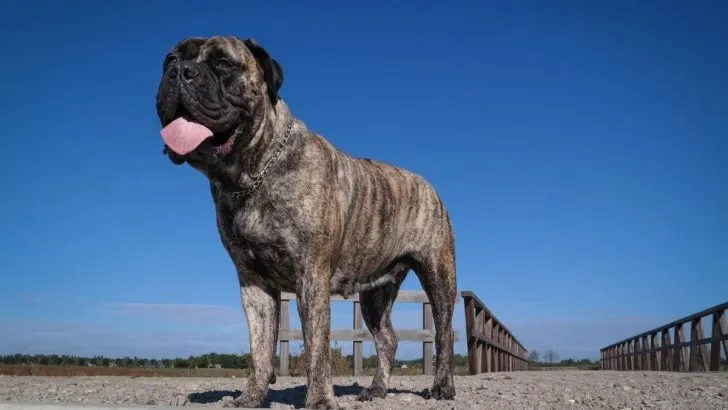Hey there, fellow pet parents!
Did you know that Bullmastiffs were originally bred to be “Gamekeeper’s Night Dogs” to guard estates from poachers? That’s right, these giant dogs have a history of being protective and loyal.
If you’re raising a young Bullmastiff or considering adding one to your family, you might be curious about how these powerful dogs grow.
That’s where a Bullmastiff growth chart comes in handy.
Let me guide you through the journey of raising a Bullmastiff from a tiny pup to a majestic adult.
Bullmastiff Growth Chart Overview
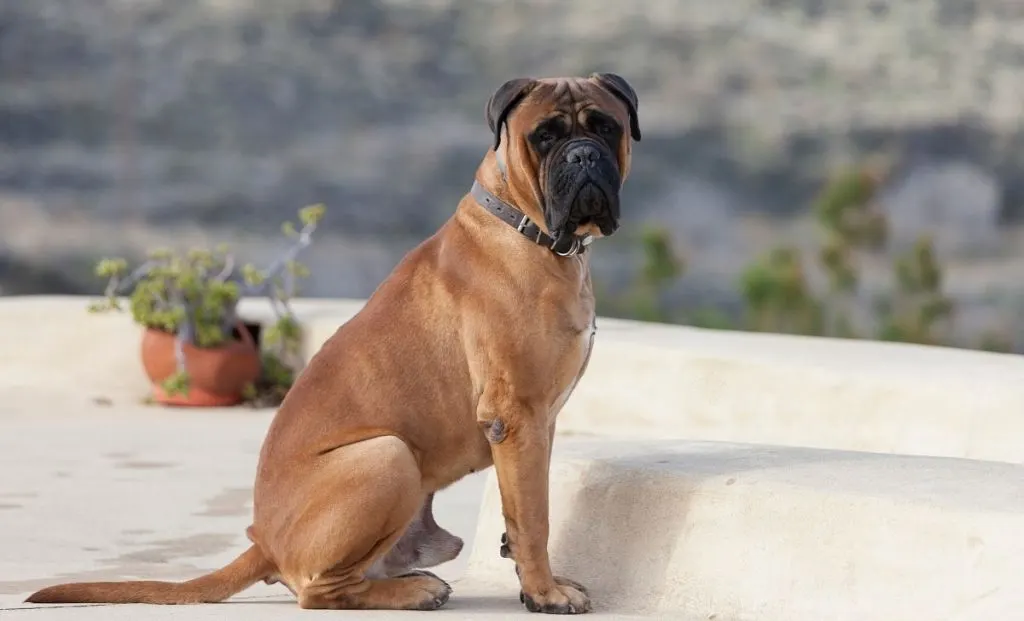
Bullmastiffs are known for their large size and gentle demeanor, making them one of the most loved breeds.
Monitoring their growth can help you ensure they are developing healthily and reaching their full potential.
Here’s a general Bullmastiff growth chart to give you an idea of what to expect as your pupper grows.
| Age (Months) | Weight (lbs) – Male | Weight (lbs) – Female | Height (Inches) – Male | Height (Inches) – Female |
| 1 | 12-15 | 10-12 | 10-12 | 9-11 |
| 3 | 30-40 | 25-35 | 15-18 | 14-17 |
| 6 | 60-70 | 55-65 | 20-24 | 19-23 |
| 9 | 80-100 | 70-90 | 22-26 | 21-25 |
| 12 | 100-120 | 85-105 | 24-27 | 23-26 |
| 18 | 110-130 | 95-115 | 25-27 | 24-26 |
| 24 (Adult) | 110-130 | 95-115 | 25-27 | 24-26 |
While it shows quite a lot, please note that this Bullmastiff growth chart still doesn’t shed much light on the individual growth of your doggo.
Each pup grows at their own pace and individual growth can vary due to genetics, diet, and overall health.
Male Bullmastiffs typically grow larger and heavier than females, so it’s essential to consider this while tracking your pup’s progress.
On the other hand, some Bullmastiff mixes may have completely different growth spurts and adult weight, depending on the purebred dog parents in the mix.
Bullmastiff Growth Chart By Age
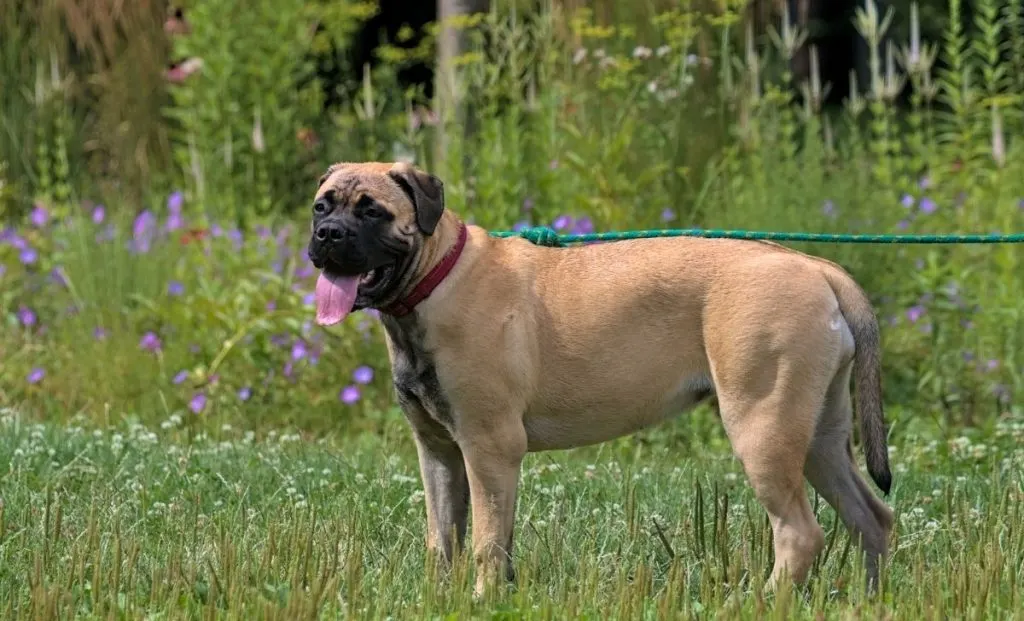
Bullmastiffs are like the gentle giants of the doggie world!
According to the official American Kennel Club (AKC) breed standards, these amazing dogs are a mix of 60% Mastiff and 40% Bulldog.
Their growth spurts are quite impressive and fascinating to watch. Let’s grow through them!
Birth To 4 Weeks
Oh, those tiny, squishy babies! When Bullmastiffs are born, they’re just adorable bundles of fur, weighing between 12 to 15 ounces.
They come into the world deaf and blind. Not being able to use their own ears and eyes, these puppies are relying entirely on their mom for warmth and nourishment. It’s the sweetest sight seeing them snuggled up with her, trying to figure out the world.
By the end of the first month, they start to open their eyes and ears, getting their first glimpses and sounds of everything around them. Is there a single thing cuter than that? I think not!
When they reach 3 weeks of age, the teething process starts and the Mastiff mama starts to gradually reduce the time spent with their puppies and the frequency of suckling.
They start to show their distinctive Bullmastiff features and weigh about 12 to 15 pounds.
2 To 3 Months

In the second and third months, these young Bullmastiff puppies begin transitioning to solid food – this process is called weaning.
In fact, this period is very important for their growth.
You see, energy requirements during weaning are crucial for optimal growth, especially in different breeds (1).
Dogs of this breed are quite big and require proper management of food intake to ensure healthy development and reduce risks of developmental diseases.
Their growth is rapid, and by three months, they can weigh between 25 to 40 pounds.
You might hear some adorable puppy cries during this time, but it’s all part of their growing up.
Just give them lots of cuddles, comfort and a little rub down to help them stop crying and feel more secure!
You may want to start training your Bullmastiff as early as 8 weeks old. Early training and socialization are two critical factors in the development of these big dogs, as they help them grow into well-behaved and balanced adults.
3 To 6 Months
Here come the playful pups! From three to six months, your Bullmastiff puppy turns into a lively bundle of joy. They’re curious, adventurous, and sometimes a bit reckless and loud – but that’s what makes them so lovable.
Their paw size starts becoming bigger, hinting at the large size they’ll reach as adults.
You’ll notice the difference between males and females more clearly now, with males typically being a bit larger and heavier.
Their beautiful, dense coat colors become more pronounced, and you might find their fur getting shinier and more vibrant
Their weight increases significantly during this phase, and by six months, they can weigh between 55 to 70 pounds.
They start showing their protective dogs instincts and strong personalities, which makes training and socialization critical.
This is the best time to socialize them as much as possible with other dogs, small children, friends, and other family members.
Despite their growing size, they’re still your cuddly puppies who need lots of love, short walks, and gentle care.
6 To 9 Months
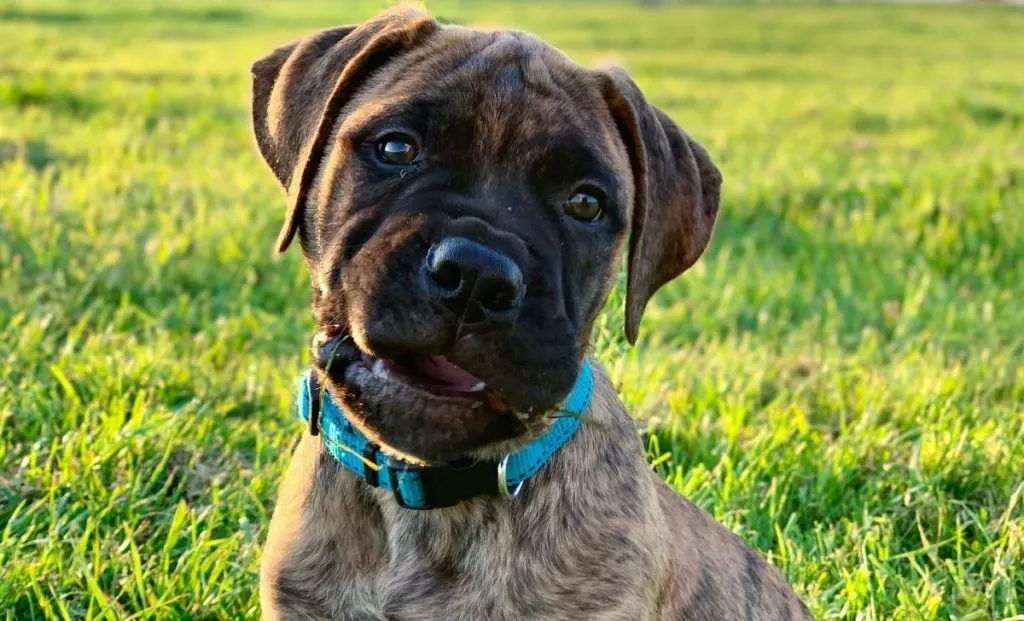
During the 6 to 9 months phase, your Bullmastiff is in full-blown puppy mode! This is an exciting and sometimes challenging time as they grow rapidly and develop their unique personalities.
During this stage, Bullmastiff puppies typically weigh between 55 to 85 pounds. They are also growing taller, reaching about 18 to 24 inches at the shoulder.
Apart from their paw size, you’ll also notice their straight back and powerful build developing more. This is also the time when their protective instincts start to show more clearly.
Bullmastiffs at this age are full of energy and curiosity. They are becoming more independent and might start testing their boundaries.
By the time they are 6 to 9 months old, they should already be familiar with basic commands like sit, stay, come, and down.
Their playful nature means they love squeaky toys and chew toys, which are necessary for keeping them entertained and helping with their dental hygiene.
Make sure to provide durable toys, as Bullmastiffs are powerful dogs with strong jaws and can be quite destructive if they don’t have appropriate items to chew on.
Regular physical checks and routine maintenance are crucial during these months to monitor their development and catch any potential health problems early.
9 To 12 Months
During this period, your pup is transitioning from puppyhood to adolescence, showing more of their majestic adult traits but still exhibiting some puppy-like behaviors.
At 9 to 12 months, Bullmastiffs have not reached their adult age yet, but they are well on their way. They are still growing and maturing, both physically and mentally.
During this phase, your Bullmastiff continues to grow in both height and weight. They typically reach around 24 to 27 inches at the shoulder and can weigh between 80 to 120 pounds.
This rapid growth requires a balanced diet rich in proteins and nutrients to support their developing muscles and bones.
Unlike small and medium dogs, Bullmastiffs have a longer growth period and require more careful monitoring of their diet and exercise to prevent joint issues.
Their larger size means they need more space to move and play. They also require more food and, unfortunately, might incur higher vet bills due to their size.
Continue regular check-ups with your vet to monitor their health and development.
Their strong, protective nature and large, imposing build make them excellent guardians, but it also means they need a strong hand in training to manage their powerful instincts.
Therefore, it’s important to reinforce obedience training. Using positive reinforcement techniques and being patient will help in managing their behavior.
12 To 18 Months
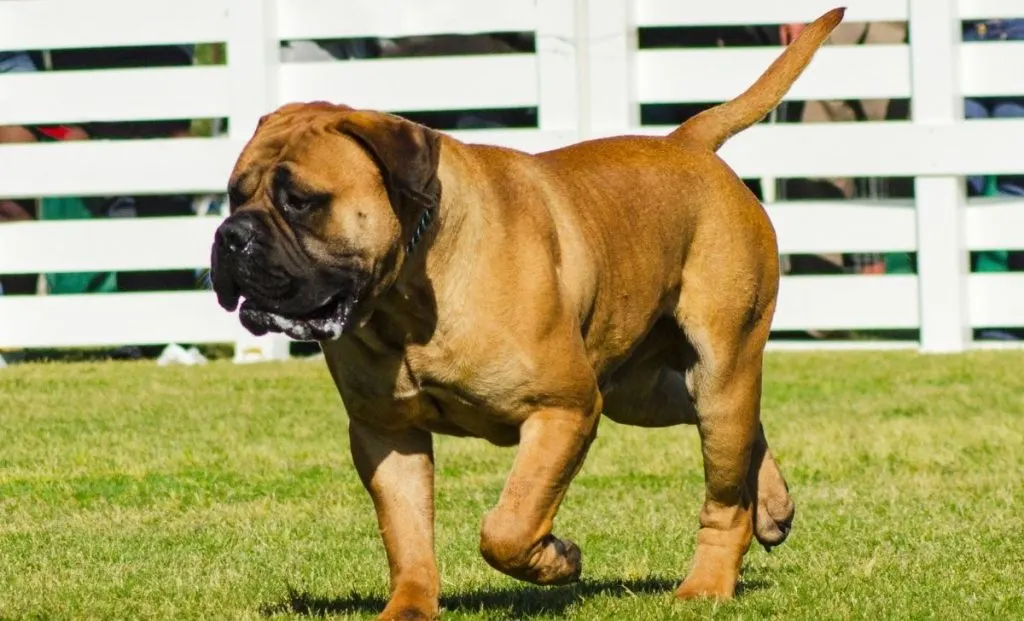
During this period, your Bullmastiff youngster looks like an adult. Well, almost.
Now, they are displaying more of their majestic traits and solidifying their place as a loyal and protective member of your family.
By now, your Bullmastiff is showing a more settled and mature demeanor.
They are nearing their full adult size and weight, typically reaching around 110 to 130 pounds for males and 95 to 115 pounds for females. They stand about 24 to 27 inches tall at the shoulder.
They might not be fully mature until they are about 2 years old, but they are getting close.
Did your pup ever dream of becoming a police dog when they were little? Well, some Bullmastiffs do achieve roles in police work due to their strength, loyalty, and intelligence.
Or maybe your dog wanted to become a show Bullmastiff? That is also possible! Sky’s the limit for these powerful dogs!
Training remains a critical factor during this stage. Taking into consideration the breed’s ferocious aspect, they still need a strong master with a firm hand to guide them effectively.
They need socialization with small and big dogs, people, and especially small children to ensure they are gentle and understanding protectors.
Compared to other similar maintenance breeds like the English Mastiff, Bullmastiffs have almost the same needs for regular exercise, a balanced diet, and routine physical check ups.
18 To 24 Months
Knowing now that they are not fully adults by month 12, you may be wondering ”How long does it take for a Bullmastiff to be fully grown?”
Well, a Bullmastiff typically takes about 18 to 24 months to be fully grown, reaching their full size and weight by around two years of age.
By now, the adult Bullmastiff should have reached their maximum height and weight, displaying all the characteristics of this mighty breed.
At this stage, their weight remains mostly stagnant, as they have reached their full growth potential.
Regular dog walks remain essential for your Bullmastiff’s physical and mental health.
7 Tips To Help Your Bullmastiff Grow Strong And Healthy
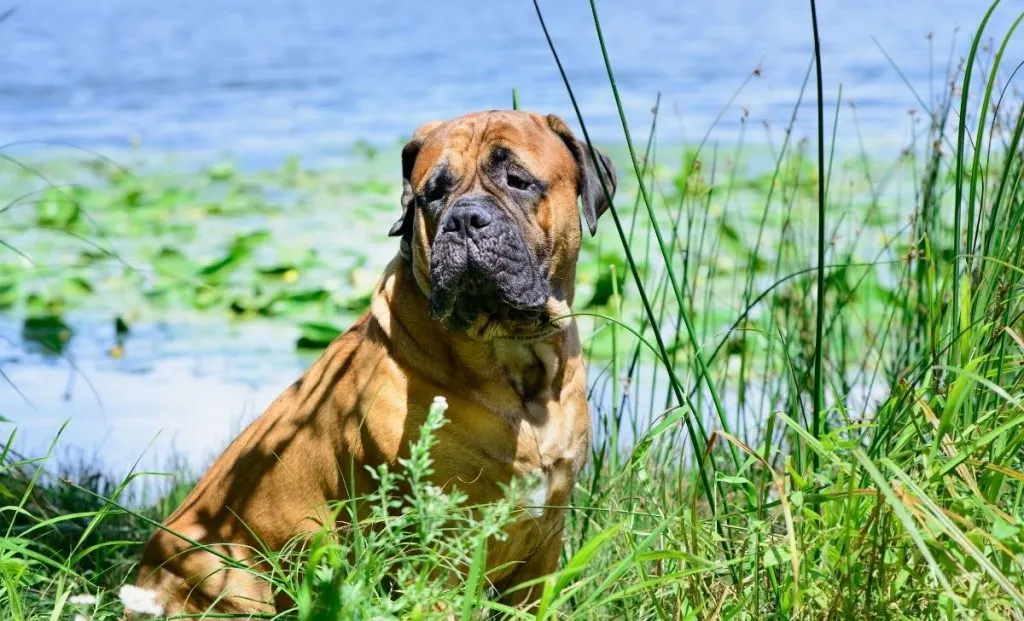
There are some important and fun things you can do to ensure your Bullmastiff grows into a strong and healthy companion.
Let’s dive into seven essential tips that will help your Bullmastiff thrive and become the magnificent, gentle giant they are meant to be!
1. Feed Them Right
Feeding your Bullmastiff the right food is like fueling a high-performance machine. Therefore, a diet filled with high-quality puppy food formulated for large breeds is a must.
Make sure they’re munching on the best to support their growth.
Avoid giving them harmful human foods like chocolate, which is toxic to dogs.
Remember, good nutrition is a critical factor in their development. Bullmastiffs, like other giant dogs such as Boerboels and Great Danes, have unique dietary needs.
2. Keep Them Active
Young Bullmastiffs love to play, and keeping them active is key! Regular, moderate exercise like short walks and fun play sessions are great for their muscles and joints.
Like other big breeds, they need exercise to stay healthy, but overexertion can cause important damage to their joints.
Think of it like this: while an adult Labrador Retriever can go on long runs, a Bullmastiff needs shorter, controlled activities.
Aim for two 20-minute dog walks each day, combined with 15-20 minutes of playtime, such as fetch or tug-of-war, in a safe, enclosed area.
3. Know Their Genes
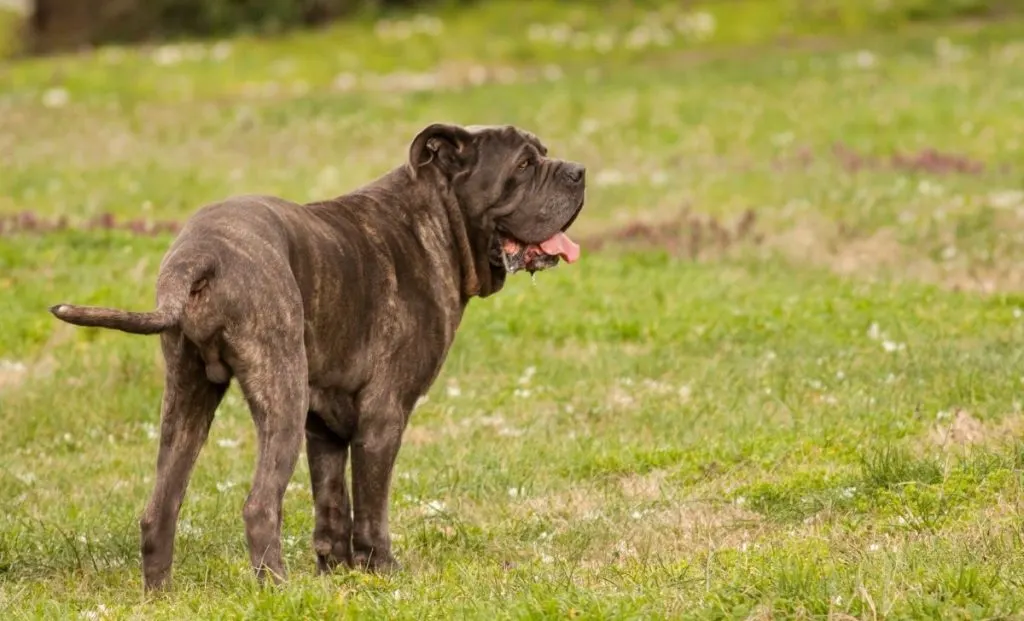
Genetics play a huge role in how Bullmastiffs grow. Some pups naturally grow bigger or faster due to their genes. Understanding your dog’s breeding program can give you a sneak peek into their future size and health.
Generations of breeding have made Bullmastiffs the powerful dogs they are today, but it also means they can have health problems.
However, such selective breeding programs have led to some health problems common to the dogs of this breed. These include hip dysplasia, heart conditions, and certain types of cancers.
In fact, research shows that they have a limited genetic pool, making them more susceptible to health issues due to inbreeding (2).
Not only does this mean that breeders should focus on increasing genetic diversity to ensure healthier dogs, but it also necessitates regular physical checks to catch and manage these potential problems early.
Also, make sure to find the best Bullmastiff breeders in your area.
4. Regular Vet Visits
I can’t stress enough the importance of regular vet visits. These check-ins are essential to ensure your Bullmastiff is growing properly and to catch any health problems early.
Regular physical checks with your English Mastiff vet are crucial. Bullmastiffs, being big dogs, might need larger amounts of medications and can incur higher vet bills.
It’s similar to the care routine for other large breeds, but because Bullmastiffs have such a solid build, they might need more frequent check-ups.
5. Train And Socialize
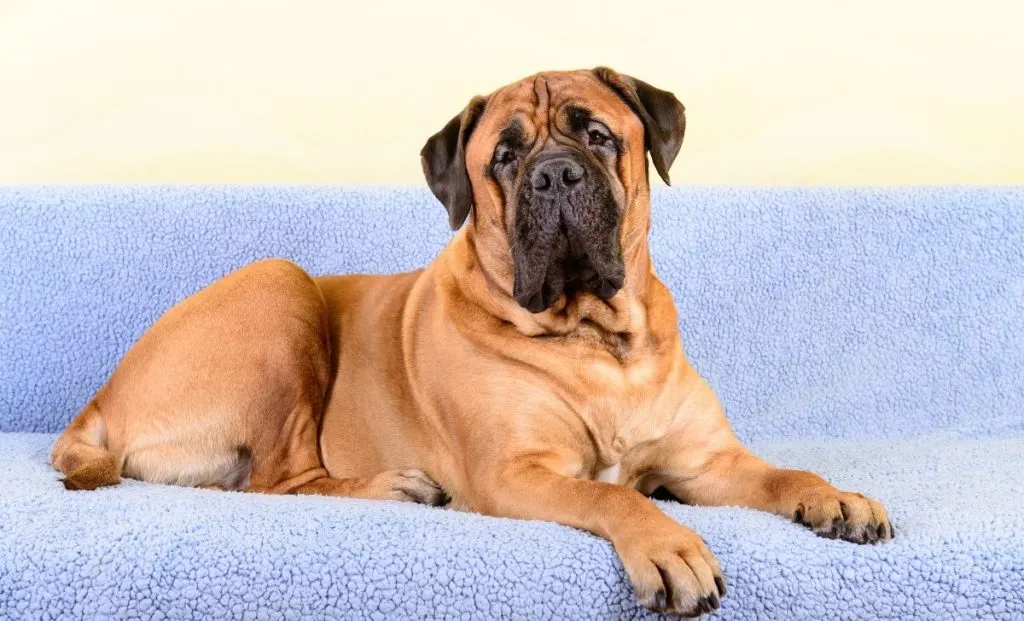
Meeting new friends and learning new tricks helps Bullmastiffs grow into confident, happy dogs.
Think of it like raising a child who dreams of being a police officer – they need guidance, discipline, and social skills.
Compared to smaller breeds, Bullmastiffs, like other large dogs, require more space and patience during training.
6. Provide Them With A Safe Place
Growing up isn’t just about how much your Bullmastiff weighs or how tall they stand, it’s also about their mental health, which is most important.
These big, powerful dogs need a quiet place to call their own. Having a consistent space helps them feel safe, reducing anxiety and giving them a routine they can rely on.
One of the best ways to do this is by using a crate, which can be like their own little den.
Crates are super helpful for house training your young Bullmastiff.
They naturally avoid soiling their sleeping area, making it easier to teach them bladder and bowel control.
Plus, crating can prevent your curious pup from getting into trouble when you’re not around, keeping them safe from harmful objects and saving your home from any important damage.
Besides a crate, designate a quiet area in your home where your Bullmastiff can retreat and relax. This can be a cozy corner with a comfy bed where they can escape the hustle and bustle of the household.
7. Monitor Their Weight
Keeping an eye on your Bullmastiff’s weight is super important for their overall health and happiness. Using this Bullmastiff growth chart makes it fun to see how your adorable pup is progressing.
In due time, with careful monitoring, your puppy will reach their ideal weight and be in great shape!
Remember that regular weigh-ins, whether at home or during vet visits are as important. They can help you track their growth.
We’re here to support you every step of the way, so enjoy each moment with your growing Bullmastiff and don’t hesitate to reach out if you need advice!
References
1. Dobenecker, B., Endres, V., & Kienzle, E. (2013). Energy requirements of puppies of two different breeds for ideal growth from weaning to 28 weeks of age.. Journal of animal physiology and animal nutrition, 97 1, 190-6 . https://doi.org/10.1111/j.1439-0396.2011.01257.x.
2. Mortlock, S., Khatkar, M., & Williamson, P. (2016). Comparative Analysis of Genome Diversity in Bullmastiff Dogs. PLoS ONE, 11. https://doi.org/10.1371/journal.pone.0147941.

Meet Iram, a devoted veterinarian, passionate dog lover, and current Ph.D. candidate at Utrecht University in the Netherlands. Seamlessly blending her roles as a vet and content writer, Iram channels her love for dogs into heartfelt narratives.
Since childhood, Iram nurtured a dream of becoming a vet, a passion that runs deep in her family. Having now fulfilled that dream, she’s eager to share her acquired knowledge. In her writing, Iram not only explores the emotional bond between humans and their canine friends but also integrates her veterinary expertise, offering readers a holistic understanding of their beloved pets.
